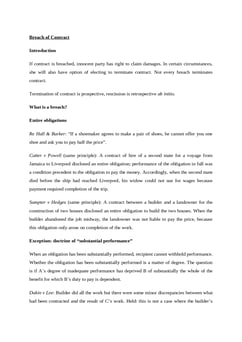Saunders v Anglia Building Soc [1971] AC 1004
Judgement for the case Saunders v Anglia Building Soc
Table Of Contents
Plaintiff wanted to make a gift of her interest in a house to X. X’s business partner, Defendant 1, got her to sign a document that she couldn’t read (she lost her glasses) but she signed when he had told her that it was a form gifting the house to X.
In fact it was to sell her interest to Defendant 1 for a sum which he never did nor intended to pay. He mortgaged her house and defaulted, so that the bank, Defendant 2, from which he took out the mortgage sough to repossess it.
Plaintiff sued Defendant 1 and Defendant 2, seeking a declaration that the assignment was invalid due to non est factum.
HL refused her claim.
Although a sale to X’s friend Defendant 1 was not the same as a gift to X, the purpose would not have been defeated had Defendant 1 actually done what he purported to be doing and paid out the money to X.
Lord Reid
-
Non est factum is used to:
To release someone where they did not in fact sign the document or
Allow someone who signed to claim it is not his deed.
Purpose 2 must be confined to narrow limits to maintain the strength of the signature rule. E.g. those:
unable to read owing to blindness or illiteracy and who therefore had to trust someone to tell them what they were signing. I think it must also apply in favour of those who are permanently or temporarily unable through no fault of their own to have without explanation any real understanding of the purport of a particular document, whether that be from defective education, illness or innate incapacity.
However they still have to take whatever precautions they reasonably can.
There is a “heavy burden of proof” on one seeking to invoke this remedy. There may be cases where, if someone was led to believe that the document didn’t affect their rights then they could use non est factum.
the essence of the plea non est factum is that the person signing believed that the document he signed had one character or one effect whereas in fact its character or effect was quite different... The amount of information he must have and the sufficiency of the particularity of his belief must depend on the circumstances of each case.
There has to be “a radical difference” (defined by circumstances of each case) or between what Plaintiff was signing and what Plaintiff thought he was signing.
Lord Wilberforce
A document should be considered void where “consent is totally lacking” or rather where “the transaction which the document purports to effect is essentially different in substance or in kind from the one intended”.
This was not the case here.
For Further Study on Saunders v Anglia Building Soc
Need instant answers? Our AI exam tutor is here to help.
Ask questions 🙋 Get answers 📔 It's simple 👁️👄👁️
Our AI is educated by the highest scoring students across all subjects and schools. Join hundreds of your peers today.
Get StartedSimilar Cases
Related Product Samples
These product samples contain the same concepts we cover in this case.
| Contract Law | Contract Law Problem Question Summary Notes (157 pages) |
| Contract Law | Mistake And Frustration Notes (18 pages) |

 Since 2010, Oxbridge Notes has been a trusted education marketplace, supplying high-quality materials from top achievers at universities like Oxford, Cambridge, LSE, Harvard, and Yale.
Since 2010, Oxbridge Notes has been a trusted education marketplace, supplying high-quality materials from top achievers at universities like Oxford, Cambridge, LSE, Harvard, and Yale.